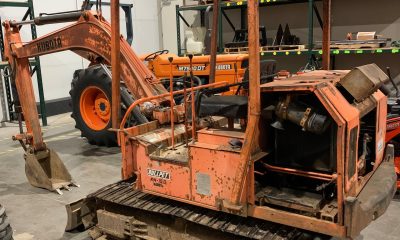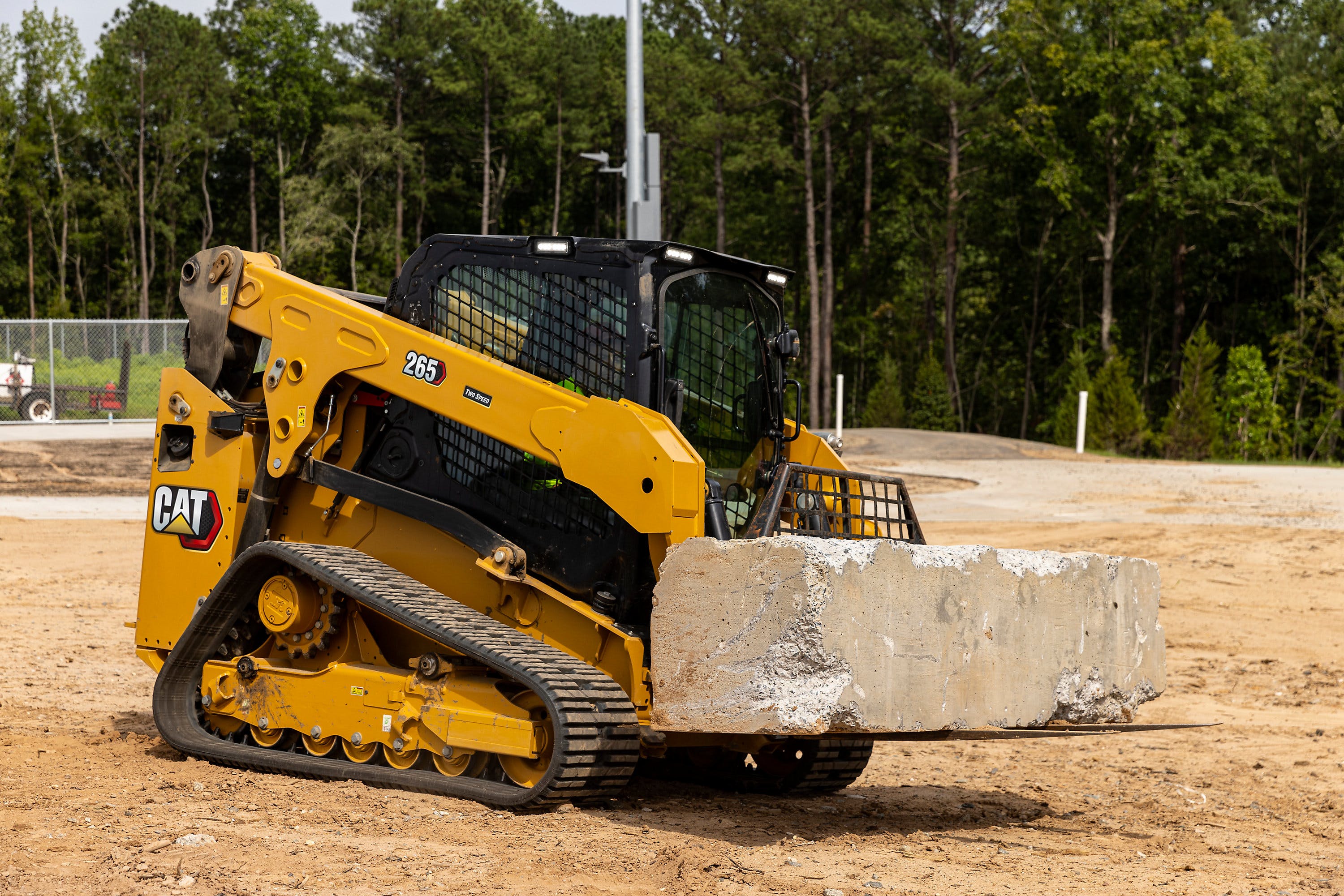Kory Anderson was about 10 years old when he first saw the only remaining boiler for a 150 Case, which was the world’s largest steam tractor in 1905.
He learned that the “Road Locomotive” as it was called no longer existed. The boiler was the closest he could get to the real thing, as all nine of the machines built had long ago been scrapped.
Seeing the boiler inspired him to want to bring the beast of a tractor back to life.
“As a boy, I just hoped my dad or one of my friends or somebody would build it,” he says. “And then as I got older, I realized it was going to have to be me.”
So in 2017, he and dozens of volunteers set out on a mission to build a replica from scratch of the largest steam tractor ever built. Sixteen months and 15,000 hours of work later, the dream became a reality.
And like the 150 Case it is modeled after, Anderson’s 150 is the largest steam tractor in the world – made official by Guinness World Records. (To see the 150 in action, check out the videos at the end of this story.)
Buying a Foundry Along the Way
 Kory with his parents, Donna and Kevin Anderson, and brother Scott on their 1911 110 Case steam tractor, which was second only to the 150 in size.Kory Anderson and the 150 Case ProjectBuilding the world’s largest steam tractor is not your typical daydream for a boy – especially not one growing up in the late-20th and early 21st centuries. But Anderson’s childhood was a little different.
Kory with his parents, Donna and Kevin Anderson, and brother Scott on their 1911 110 Case steam tractor, which was second only to the 150 in size.Kory Anderson and the 150 Case ProjectBuilding the world’s largest steam tractor is not your typical daydream for a boy – especially not one growing up in the late-20th and early 21st centuries. But Anderson’s childhood was a little different.
His parents, Kevin and Donna Anderson, were steam engine hobbyists and historians. He learned at a young age how to operate and work on the old tractors. He restored a 1915 65 Case steam tractor at age 16. He also made it known to all of the family’s friends and co-hobbyists of his desire to one day see a 150 Case.
At 22 years old, he made a trip to the Case archives in Racine, Wisconsin. As luck would have it, the company still had about 90% of the drawings and blueprints for the 150, which was designed more than 100 years ago.
In its day, the 150 was about three times larger than other steam tractors. The J.I. Case Company built nine of the Road Locomotives between 1905 and 1907. They were designed to fill in gaps on the railroad by hauling heavy freight over road. A copper mine in New Mexico was the first customer.
There wasn’t much of a market for the 150. But its design was later used for a smaller steam tractor for plowing that became a big seller, the 110 Case.
The remaining 150s returned to Racine. Some were stripped down for the engines to be sold for use at sawmills or generating electricity. After Case was bought by Tenneco in 1972, all the remains of the 150s had been scrapped. The boiler Anderson saw when he was a child was all that was left.
Anderson began making 3D computer-aided design (CAD) models from the drawings he had copied at Case headquarters and then advanced to making wood patterns. Meanwhile, he had started a welding, fabrication, machining and engineering company, Anderson Industries, and would cast parts for the tractor in his spare time. His successful business also helped fund his project, which ended up costing about $1.5 million.
Then in 2014, the Dakota Foundry in Webster, South Dakota, where he had been a customer for eight years for parts casting announced it was being sold to a company in Taiwan. Along with no longer having a place to cast the 150’s parts, a lot of his friends would be out of work.
“I had to buy a foundry along the way to be able to do all the casting,” Anderson says. “I also wanted to see the business saved and not shut down.”
A Sense of Urgency
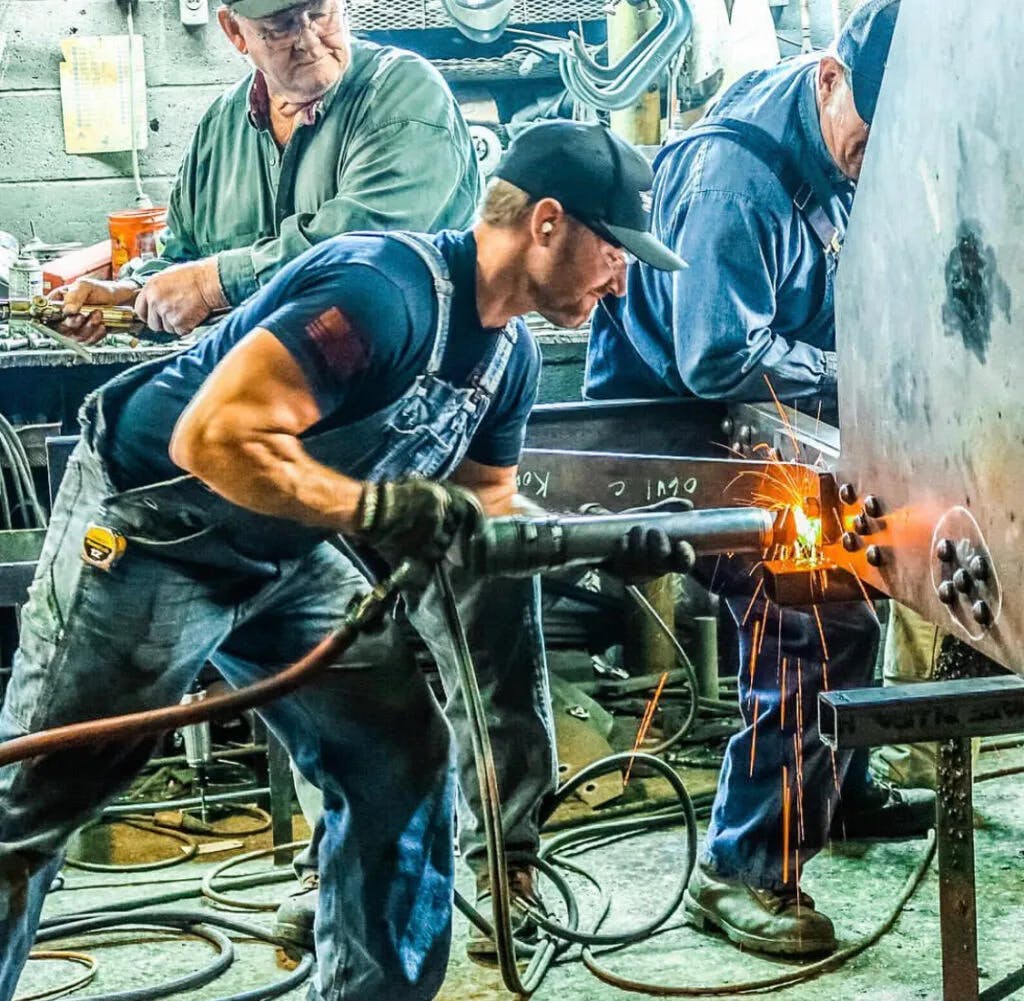 Kory Anderson at work on the 150 CaseKory Anderson and the 150 Case ProjectAs 2017 rolled around, Anderson knew he needed to move quickly if he was going to build a 150 Case. His mentors in the steam world were getting older.
Kory Anderson at work on the 150 CaseKory Anderson and the 150 Case ProjectAs 2017 rolled around, Anderson knew he needed to move quickly if he was going to build a 150 Case. His mentors in the steam world were getting older.
“I realized that I wouldn’t have any of my knowledge and I wouldn’t have this dream if it wasn’t for the mentors who shared the stories and taught me everything that I knew,” he says. “So it really became a drive of mine to get it started and get it finished as fast as I could just so that they could appreciate it and enjoy it before they passed on.”
So he and friend Gary Bradley began building the engine. Anderson would make the 8-hour drive each weekend from South Dakota to Bradley’s shop in Sheridan, Wyoming, where they had all the tools and equipment they needed and were free from the interruptions of day-to-day business at the foundry.
Work on other parts of the tractor was occurring elsewhere simultaneously by volunteers under Anderson’s coordination.
The wheels, extension rims and drawbar were being built and riveted together at friend Jim Briden’s shop in Fargo, North Dakota.
Trevor Guenter and a team worked on fabricating and riveting together the water tank and coal bunkers in Manitoba, Canada.
More than 10,000 followers on Facebook monitored the progress as the team rushed to meet a deadline of September 8, 2018, when the tractor would make its debut at the James Valley Threshing Show in Andover, South Dakota.
“A Whole Different Monster”
 Kory Anderson with longtime mentor Jim Briden with the finished 150 Case.Kory Anderson and the 150 Case ProjectAnderson was nervous when it came time to fire up the engine for the first time, about three weeks before the 150’s big public debut.
Kory Anderson with longtime mentor Jim Briden with the finished 150 Case.Kory Anderson and the 150 Case ProjectAnderson was nervous when it came time to fire up the engine for the first time, about three weeks before the 150’s big public debut.
“Anytime you completely rebuild something, there’s always potential for missing something or something not being 100% right,” he says. “It’s like rebuilding a motor and then starting it for the first time. You’re just kind of listening for any issues.
“But this thing being completely built from scratch and none existing, it was just a whole different monster.”
The 150 weighs 37.5 tons. Each wheel is 8 feet in diameter and weighs over 3 tons. The volunteers installed over 1,000 ¾-inch hot rivets for them.
In all, the tractor is 25 feet long, 14 feet wide and stands 14 feet tall. The bunkers have a capacity for 3 tons of coal, and the water tank will hold 600 gallons of water. The engine burns both wood and coal to maintain an operating pressure of 180 psi of steam.
Anderson and team members lit the first match for the engine on August 18, 2018. It ran without a hitch.
“It was just an incredible thrill to see it moving under its own power and everything moving smoothly and operating well,” Anderson says.
Going Viral
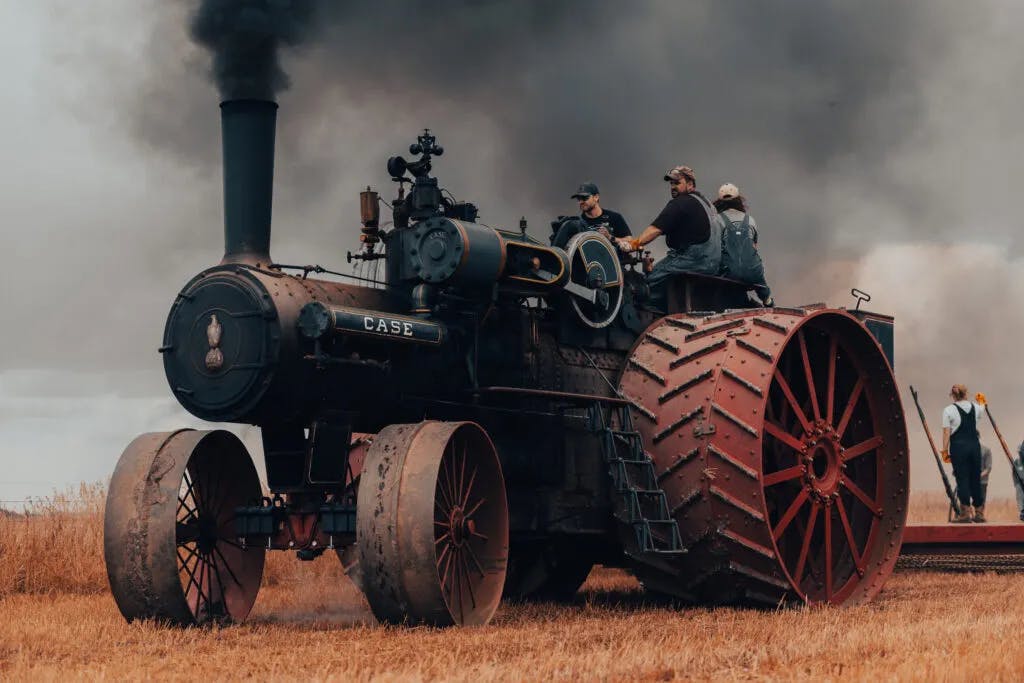 Kory Anderson and the 150 Case ProjectJust as the engine started as it should, so did the tractor’s performance at public events.
Kory Anderson and the 150 Case ProjectJust as the engine started as it should, so did the tractor’s performance at public events.
It sounds like a train locomotive and looks like one, too, as smoke billows from its stack.
YouTube videos of its feats of hauling rows of John Deere bottom plows have logged more than 20 million views.
Its largest pull to date came in 2022 when it hauled 50 Deere plows all connected together, along with an operator at each plow. Anderson says you couldn’t tell anything was behind the 150 because of its power. It has a top speed of 5.69 mph and delivers 5,000 foot-pounds of torque.
Despite its size, Anderson says, it’s fairly easy to operate – as long as you learn who’s boss.
“It is a brute. Everything on it is heavy. And if you try to fight it, it’s going to fight back. And it’s probably going to win.”
It has three levers, one for forward and reverse, one for throttle and one for “power steering.” The steering takes the most time to get used to. “You’re only able to turn at the speed the engine is moving,” he explains. “You’ve got to plan everything out, because if you get behind, you’re not going to be able to catch up, because you’re only turning that speed of the engine.”
Anderson says he has become comfortable operating the big tractor.
“Now I’ve run it enough, and I feel like a really experienced guy in an excavator,” he says. “You just become one with the machine.”
Guinness Comes Calling
 Kory Anderson and the 150 Case Project“I never really expected that it would gain the traction that it has,” Anderson says of his 150.
Kory Anderson and the 150 Case Project“I never really expected that it would gain the traction that it has,” Anderson says of his 150.
But the viral YouTube videos created a sensation, so much so that he was hearing responses from unlikely corners, inspiring him to do more to show the big 150.
“What really inspired me the most was the amount of parents that I had coming to me saying, ‘My kids used to watch all this stuff on TV and YouTube, and now all they want to do is watch your steam engine videos.’”
The 150 also caught the attention of the famous Guinness World Records.
“They actually reached out to me,” he says. “They had come across the videos on YouTube.”
Guinness sent him an email announcing its intentions to review the tractor for entry into its world records.
In November 2022, Anderson got official word from Guinness that the 150 is the world’s largest steam-powered tractor.
What’s Next?
Anderson has shown the 150 several times and also attends steam engine shows to talk about building the world’s largest steam tractor.
His goal is to motivate others.
“You can have a dream, and as long as you’re willing to put in the work, anything is possible,” he says.
He also talks about finding the right team to help you and support your goals. He praises all the many volunteers who worked on the 150. And now that the 150 is finished, he’s paying back some of those friends by helping them build steam tractors of their own.
He’s also on the lookout for another big project, but they’re not easy to find. He wants to make sure whatever he does is 100% authentic like the 150. But many of the steam tractor manufacturers have been out of business for decades, so the blueprints and designs are difficult to find.
“I have my feelers out there trying to track things down,” he says. “So we’ll see what I can come up with.”
Watch the 150 in Action
Check out these videos below from Kory Anderson and the 150 Case Project of the 150 Case in action.
The video below shows the tractor pulling 44 John Deere bottom plows with some great drone footage at James Valley Threshing Show in Andover, South Dakota, in 2021:
In the video below, the 150 Case Road Locomotive pulls 50 John Deere plows in 2022, its largest feat so far. “There were areas where the plows wouldn’t go in deep enough to pull smooth, but rather bulldozed a 60′ swath,” according to the YouTube video description. “Over 80,000 lbs. of direct pull on the hitch to drag this load across the field, a remarkable showing of the power of steam!”

 Business5 years ago
Business5 years ago
 Business3 years ago
Business3 years ago
 Tech3 years ago
Tech3 years ago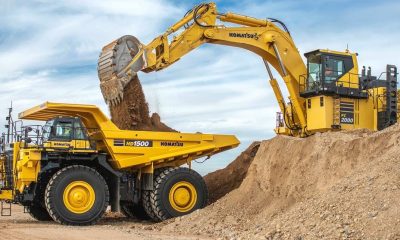
 Tech2 years ago
Tech2 years ago












